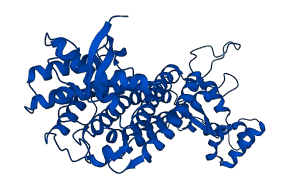Q7WG65
Gene name |
fumC |
Protein name |
Fumarate hydratase class II |
Names |
Fumarase C, Aerobic fumarase, Iron-independent fumarase |
Species |
Bordetella bronchiseptica (strain ATCC BAA-588 / NCTC 13252 / RB50) (Alcaligenes bronchisepticus) |
KEGG Pathway |
bbr:BB4054 |
EC number |
4.2.1.2: Hydro-lyases |
Protein Class |
|

Descriptions
The autoinhibited protein was predicted that may have potential autoinhibitory elements via cis-regPred.
Autoinhibitory domains (AIDs)
Target domain |
|
Relief mechanism |
|
Assay |
cis-regPred |
Accessory elements
No accessory elements
Autoinhibited structure

Activated structure

1 structures for Q7WG65
| Entry ID | Method | Resolution | Chain | Position | Source |
|---|---|---|---|---|---|
| AF-Q7WG65-F1 | Predicted | AlphaFoldDB |
No variants for Q7WG65
| Variant ID(s) | Position | Change | Description | Diseaes Association | Provenance |
|---|---|---|---|---|---|
| No variants for Q7WG65 | |||||
No associated diseases with Q7WG65
Functions
| Description | ||
|---|---|---|
| EC Number | 4.2.1.2 | Hydro-lyases |
| Subcellular Localization |
|
|
| PANTHER Family | ||
| PANTHER Subfamily | ||
| PANTHER Protein Class | ||
| PANTHER Pathway Category | No pathway information available | |
1 GO annotations of cellular component
| Name | Definition |
|---|---|
| tricarboxylic acid cycle enzyme complex | Any of the heteromeric enzymes that act in the TCA cycle. |
1 GO annotations of molecular function
| Name | Definition |
|---|---|
| fumarate hydratase activity | Catalysis of the reaction: (S)-malate = fumarate + H(2)O. |
2 GO annotations of biological process
| Name | Definition |
|---|---|
| fumarate metabolic process | The chemical reactions and pathways involving fumarate, the anion of trans-1,2-ethenedicarboxylic acid, the diastereoisomer of maleate. It is a key intermediate in metabolism and is formed in the TCA cycle from succinate and converted into malate. |
| tricarboxylic acid cycle | A nearly universal metabolic pathway in which the acetyl group of acetyl coenzyme A is effectively oxidized to two CO2 and four pairs of electrons are transferred to coenzymes. The acetyl group combines with oxaloacetate to form citrate, which undergoes successive transformations to isocitrate, 2-oxoglutarate, succinyl-CoA, succinate, fumarate, malate, and oxaloacetate again, thus completing the cycle. In eukaryotes the tricarboxylic acid is confined to the mitochondria. See also glyoxylate cycle. |
No homologous proteins in AiPD
| UniProt AC | Gene Name | Protein Name | Species | Evidence Code |
|---|---|---|---|---|
| No homologous proteins | ||||
| 10 | 20 | 30 | 40 | 50 | 60 |
| MKTRTEKDTF | GPIEVPEQHL | WGAQTQRSLH | FFAISTEKMP | VPLVAAMARL | KRAAAKVNAE |
| 70 | 80 | 90 | 100 | 110 | 120 |
| LGELDPQVAD | AIMRAADEVV | AGKWPDEFPL | SVWQTGSGTQ | SNMNMNEVLA | NRASELLGGE |
| 130 | 140 | 150 | 160 | 170 | 180 |
| RGEGRKVHPN | DHVNRGQSSN | DTFPTAMHVA | AAVEVEHRVL | PALKALRGTL | AAKSAAFYDI |
| 190 | 200 | 210 | 220 | 230 | 240 |
| VKIGRTHLQD | ATPLTLGQEI | SGYVAQLDLA | EQQIRATLAG | LHQLAIGGTA | VGTGLNAHPQ |
| 250 | 260 | 270 | 280 | 290 | 300 |
| FSAKVSAELA | HDTGSAFVSA | PNKFQALASH | EALLFAHGAL | KTLAAGLMKI | ANDVRWLASG |
| 310 | 320 | 330 | 340 | 350 | 360 |
| PRSGLGEISI | PENEPGSSIM | PGKVNPTQCE | AVTMLAAQVM | GNDVAINVGG | ASGNFELNVF |
| 370 | 380 | 390 | 400 | 410 | 420 |
| KPLVIHNFLQ | SVRLLADGMV | SFDKHCAAGI | EPNRERITEL | VERSLMLVTA | LNPHIGYDKA |
| 430 | 440 | 450 | 460 | ||
| AQIAKKAHKE | NLSLKEAALA | LGHLTEAQFA | EWVVPGDMTN | ARR |